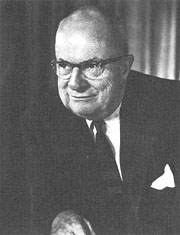Chase Aircraft
C-123 |
The Chase Aircraft Company, founded in 1943, was an American
Early products
Founded in

By 1949, the
XG-20 and the first jet transport
Meanwhile, a third, still larger, assault glider had been designed by Stroukoff, the XG-20, the largest glider ever built in the United States and also the last combat glider to be constructed for the U.S. military.[7] By the time the XG-20 was ready for flight testing, gliders had been determined to be obsolete as weapons of war, and so the two aircraft were taken aside for modification. The first prototype XG-20 was fitted with twin radial engines of a larger, more powerful type than those fitted to the YC-122, and was redesignated the XC-123.[8]
The second prototype XG-20, following public display in early 1950 at
Kaiser and the pricing scandal

While the XC-123A proved too uneconomical for production,[4] the XC-123 had greatly impressed the Air Force, which issued an order for five pre-production aircraft, designated C-123B.[1] The prospect of large follow-up orders, however, raised an issue of capacity, as Chase's factory lacked sufficient space to construct large numbers of aircraft.[10] Therefore, in 1951, 49 percent of Chase was purchased by Kaiser-Frazer,[10] who received a contract for 300 C-123B aircraft to be constructed at Kaiser's Willow Run factory in Ann Arbor, Michigan.[10] Chase became an engineering shop for the company, with Stroukoff remaining with the facility as its chief engineer.[10]
However, even as the first eight aircraft were under construction by Kaiser, the
The result of the hearings was the cancellation of Kaiser's contracts for both the C-119 and the C-123 in June 1953,[11] despite the Air Force having already spent $30 million on preparation for production of the C-123, with another $40 million having been earmarked for use by Chase Aircraft directly for production of parts.[12] The C-123 contract was put out for re-bid, with Fairchild proving to be the winning contractor;[13] under Fairchild's name, the C-123 went on to see a large production run and extensive service in the Vietnam War.[14]
Dissolution
Kaiser-Frazer, meanwhile, had bought out the remaining 51% of Chase Aircraft's shares, intending to operate the company as a wholly owned subsidiary of
Without the C-123 contract, the new acquisition was no longer considered an asset by Kaiser-Frazer; and it announced that the company would be closed down on January 31, 1954.[16] Stroukoff, however, acquired the buildings and remaining assets of Chase, starting his own aircraft company, Stroukoff Aircraft, to conduct further work on experimental versions of the C-123.[10]
References
- Notes
- Citations
- ^ a b Gunston 1987, p.146.
- ^ Bridgman 1951, p. 214c
- ^ Institute of the Aeronautical Sciences, 1948. Aeronautical Engineering Review, Volume 7, p.9
- ^ a b Mitchell 1992, p.164.
- ^ a b c World Aircraft Information Files, File 891 Sheet 26. London: Bright Star Publishing.
- ^ Kuhn 1960, p.259.
- ^ Sergievsky et al. 1998, p.128
- ^ Andrade 1979, p. 87.
- ^ Shrader 1953, p.136.
- ^ a b c d e f g Pattillo 2000, pp.165-166.
- ^ a b c d Life July 6, 1953, p.22
- ^ "Aviation: The Ax for Willow Run". Time. July 6, 1953.
- ^ Gunston 1977, p. 164.
- ^ Adcock 1992, pp.8-21
- ^ Ward's automotive yearbook, Volume 16 (1954), p.121.
- ^ "Kaiser To Close Chase Plant In New Jersey". American Aviation, Volume 17 (1953), p.15.
- Bibliography
- Adcock, Al (1992). C-123 Provider In Action. Aircraft. Vol. 124. Carrollton, TX: Squadron/Signal Publications. ISBN 978-0-89747-276-0.
- Andrade, John (1979). U.S. Military Aircraft Designations and Serials since 1909. Leicester, UK: Midland Counties Publications. ISBN 0-904597-22-9.
- Bridgman, Leonard (1951). Jane's All The World's Aircraft 1951–52. London: Sampson Low, Marston & Company, Ltd.
- Bridgman, Leonard (1958). Jane's All The World's Aircraft 1958–59. London: Sampson Low, Marston & Company, Ltd.
- The Editors (July 6, 1953). "Kaiser Cancellation: Henry J's 'boxcars' cost too much for Air Force". Life. Vol. 35, no. 1. Time Inc. Retrieved 2010-11-29.
{{cite magazine}}:|author=has generic name (help) - Gunston, Bill (1980). The Encyclopedia of World Air Power. New York: Crescent Books. ISBN 0-517-53754-0.
- Gunston, Bill (1987). The Encyclopedia of World Air Power (Revised ed.). New York: Crescent Books. ISBN 978-0-517-49969-6.
- Kuhn, Gary S. (1960). "New Lives of the Chase YC-122". AAHS Journal. 5. Santa Ana, CA: American Aviation Historical Society. Retrieved 2010-11-29.
- Mitchell, Kent A. (1992). "The C-123 Provider". AAHS Journal. 37. Santa Ana, CA: American Aviation Historical Society.
- Pattillo, Donald M. (2000). Pushing the Envelope: The American Aircraft Industry. Ann Arbor, MI: University of Michigan Press. ISBN 978-0-472-08671-9. Retrieved 2010-11-26.
- Sergievsky, Boris; Allan Forsyth; Adam Hochschild (1998). Airplanes, Women, and Song: Memoirs of a Fighter Ace, Test Pilot, and Adventurer. Syracuse, NY: Syracuse University Press. ISBN 978-0-8156-0545-4.
- Shrader, Welman Austin (1953). Fifty years of flight: a Chronicle of the Aviation Industry in America, 1903-1953. Cleveland, OH: Eaton Manufacturing Company. ASIN B0006ATK3C. Retrieved 2010-11-27.
